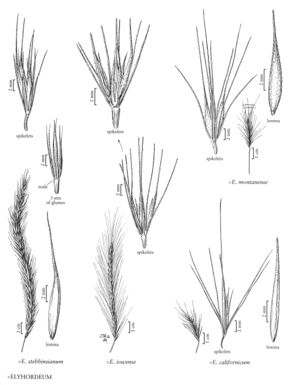Difference between revisions of "×elyhordeum stebbinsianum"
Treatment appears in FNA Volume 24. Treatment on page 286.
FNA>Volume Importer |
imported>Volume Importer |
||
| Line 38: | Line 38: | ||
|publication year= | |publication year= | ||
|special status= | |special status= | ||
| − | |source xml=https:// | + | |source xml=https://bibilujan@bitbucket.org/aafc-mbb/fna-data-curation.git/src/bb6b7e3a7de7d3b7888a1ad48c7fd8f5c722d8d6/coarse_grained_fna_xml/V24/V24_410.xml |
|subfamily=Poaceae subfam. Pooideae | |subfamily=Poaceae subfam. Pooideae | ||
|tribe=Poaceae tribe Triticeae | |tribe=Poaceae tribe Triticeae | ||
Revision as of 21:46, 27 May 2020
Culms 60-80 cm. Blades 3-5 mm wide, abaxial surfaces smooth, adaxial surfaces scabridulous. Inflorescences spikelike, 10-16 cm, with 3 spikelets per node; internodes averaging 3.4 mm. Spikelets with 1-3 florets, the lateral spikelets sessile or pedicellate, pedicels to 3 mm. Glumes 0.5-1 mm wide, terminating in a 4-7 mm awn; lemmas glabrous to scabrous, awned, awns 5-11 mm; anthers indehiscent. 2n = unknown.
Distribution
Calif., Oreg., Wash.
Discussion
×Elyhordeum stebbinsianum consists of hybrids between Elymus glaucus and Hordeum brachy-antherum. Bowden (1958) reported that they appear to be completely sterile. They have been found at scattered locations in western North America.
Selected References
None.
Lower Taxa
None.
... more about "×elyhordeum stebbinsianum"
